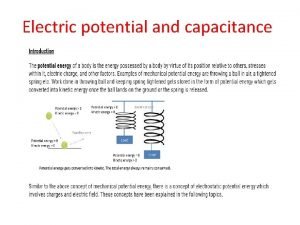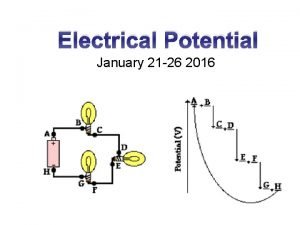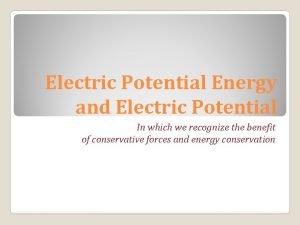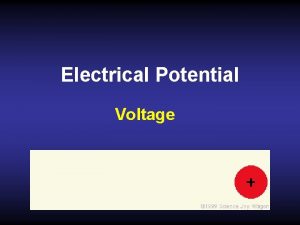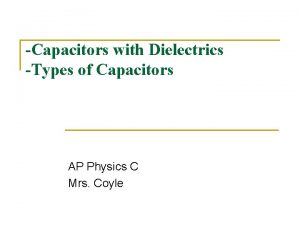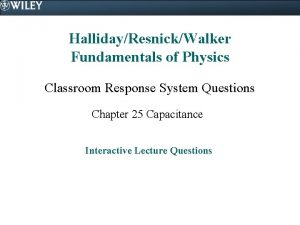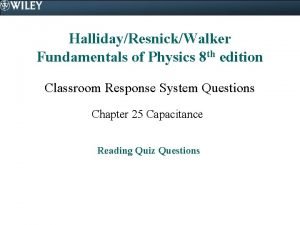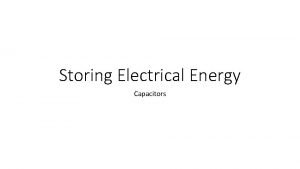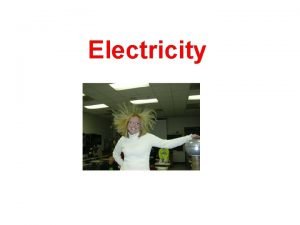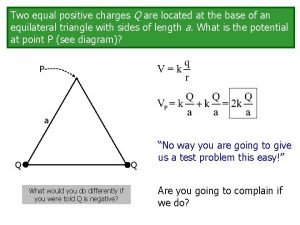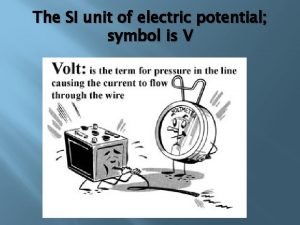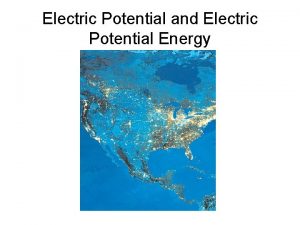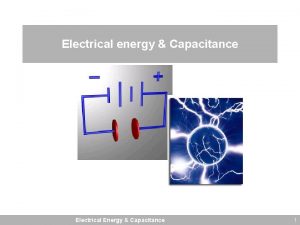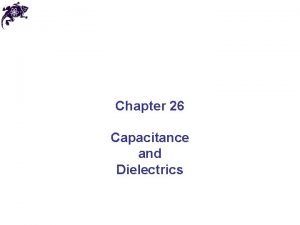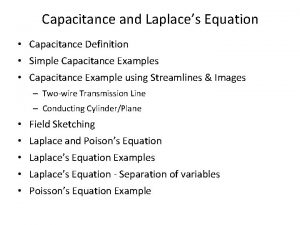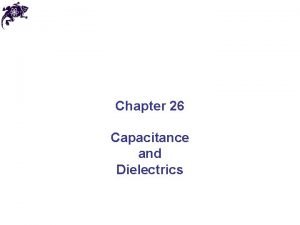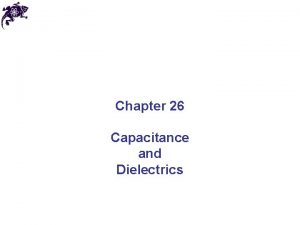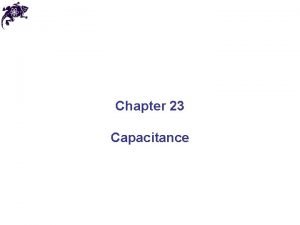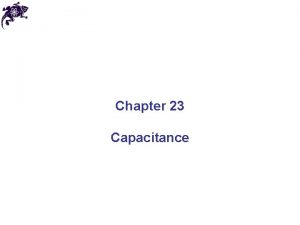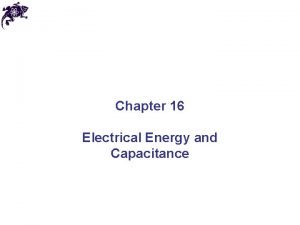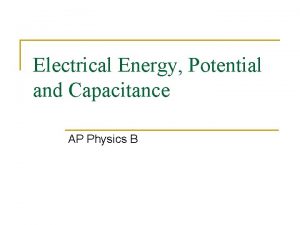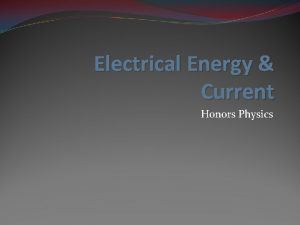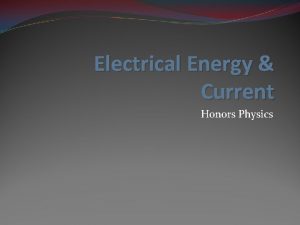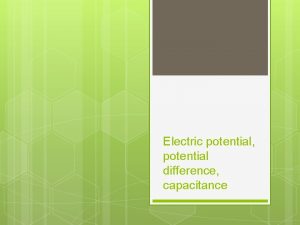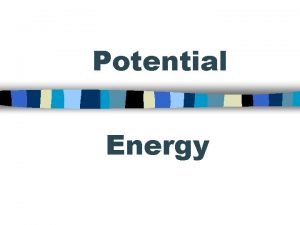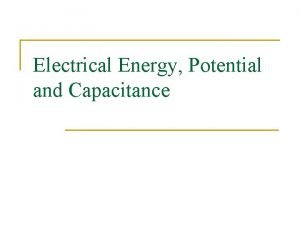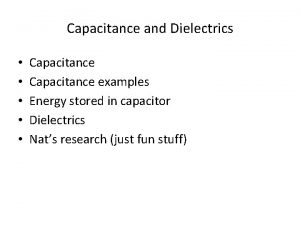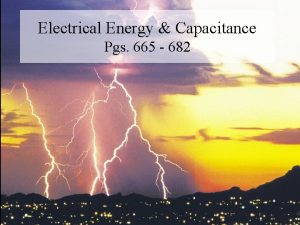Electrical Energy Potential and Capacitance AP Physics Two










































- Slides: 42

Electrical Energy, Potential and Capacitance AP Physics

Two equal and opposite charges are fixed to a grid at the locations shown. Four points in the vicinity of these charges are labeled A - D. Rank the electric potential at the labeled points. Explain your reasoning.

Two equal and opposite charges are fixed to a grid at the locations shown. Four points in the vicinity of these charges are labeled A - D. Rank the electric potential at the labeled points. Explain your reasoning. B > A = C > D. The potential is zero at A and C because the two charges are the same distance from each of these points and one charge contributes a positive potential and the other a negative. B is the point with the largest potential since it is closest to the positive charge and D is the lowest potential since it is negative.

Notes: Electric Fields

Notes: Uniform Electric Fields Non - Uniform

The diagram below shows some of the equipotentials in a plane perpendicular to two parallel charged metal cylinders. The potential of each line is labeled. A. The left cylinder is charged positively. What is the sign of the charge on the other cylinder? B. Draw a diagram like the one to the right, sketch lines to describe the electric field produced by the charged cylinders. C. Determine the potential difference, VA – VB, between points A and B. D. How much work is done by the field if a charge of 0. 50 coulomb is moved along a path from point A to point E and then to point D?

The diagram below shows some of the equipotentials in a plane perpendicular to two parallel charged metal cylinders. The potential of each line is labeled. A. The left cylinder is charged positively. What is the sign of the charge on the other cylinder? Positive! B. Draw a diagram like the one to the right, sketch lines to describe the electric field produced by the charged cylinders. C. Determine the potential difference, VA – VB, between points A and B. VA – VB = (– 20 V) – (– 10 V) = – 10 V D. How much work is done by the field if a charge of 0. 50 coulomb is moved along a path from point A to point E and then to point D? WAED= WAD= ΔEp =qΔV = (0. 5 C)(30 V) = +15 J

Three point charges produce the electric equipotential lines shown on the diagram below. a. Draw arrows at points L, N. and U on the diagram to indicate the direction of the electric field at these points. b. At which of the lettered points is the electric field E greatest in magnitude? Explain your reasoning. c. Compute an approximate value for the potential difference, VM – VS, between points M and S. d. Determine the work done by the field if a charge of +5. 0 × 10– 12 coulomb is moved from point M to point R. e. If the charge of +5. 0× 10– 12 coulomb were moved from point M first to point S, and then to point R, would the answer to e. be different, and if so, how?

Three point charges produce the electric equipotential lines shown on the diagram below. a. Draw arrows at points L, N. and U on the diagram to indicate the direction of the electric field at these points. b. At which of the lettered points is the electric field E greatest in magnitude? Explain your reasoning. The magnitude of the field is greatest at point T because the equipotential lines are closest together. c. Compute an approximate value for the potential difference, VM – VS, between points M and S. VM – VS = 40 V – 5 V = 35 V d. Determine the work done by the field if a charge of +5. 0× 10– 12 coulomb is moved from point M to point R. W = qΔV and ΔV = 10 V which gives W = 5. 0 × 10 – 11 J e. If the charge of +5. 0× 10– 12 coulomb were moved from point M first to point S, and then to point R, would the answer to d. be different, and if so, how? The work done is independent of the path so the answer would be the same.

Electric Fields and WORK Consider a negative charge moving in between 2 oppositely charged parallel plates initial KE=0 Final KE= 0, therefore in this case Work = DPE We call this ELECTRICAL potential energy, UE, and it is equal to the amount of work done by the ELECTRIC FORCE, caused by the ELECTRIC FIELD over distance, d, which in this case is the plate separation distance. Is there a symbolic relationship with the FORMULA for gravitational potential energy?

Electric Potential Here we see the equation for gravitational potential energy. Instead of gravitational potential energy we are talking about ELECTRIC POTENTIAL ENERGY A charge will be in the field instead of a mass The field will be an ELECTRIC FIELD instead of a gravitational field The displacement is the same in any reference frame and use various symbols Putting it all together! Question: What does the LEFT side of the equation mean in words? The amount of Energy per charge!

Energy per charge The amount of energy per charge has a specific name and it is called, VOLTAGE or ELECTRIC POTENTIAL (difference). Why the “difference”?

Understanding “Difference” Let’s say we have a proton placed between a set of charged plates. If the proton is held fixed at the positive plate, the ELECTRIC FIELD will apply a FORCE on the proton (charge). Since like charges repel, the proton is considered to have a high potential (voltage) similar to being above the ground. It moves towards the negative plate or low potential (voltage). The plates are charged using a battery source where one side is positive and the other is negative. The positive side is at 9 V, for example, and the negative side is at 0 V. So basically the charge travels through a “change in voltage” much like a falling mass experiences a “change in height. (Note: The electron does the opposite)

BEWARE!!!!!! W is Electric Potential Energy (Joules) is not V is Electric Potential (Joules/Coulomb) a. k. a Voltage, Potential Difference

The “other side” of that equation? Since the amount of energy per charge is called Electric Potential, or Voltage, the product of the electric field and displacement is also VOLTAGE This makes sense as it is applied usually to a set of PARALLEL PLATES. DV=Ed DV E d

Example A pair of oppositely charged, parallel plates are separated by 5. 33 mm. A potential difference of 600 V exists between the plates. (a) What is the magnitude of the electric field strength between the plates? (b) What is the magnitude of the force on an electron between the plates? 113, 207. 55 N/C 1. 81 x 10 -14 N

Example Calculate the speed of a proton that is accelerated from rest through a potential difference of 120 V 1. 52 x 105 m/s

Electric Potential of a Point Up to this point we have focused our attention solely to Charge that of a set of parallel plates. But those are not the ONLY thing that has an electric field. Remember, point charges have an electric field that surrounds them. So imagine placing a TEST CHARGE out way from the point charge. Will it experience a change in electric potential energy? YES! Thus is also must experience a change in electric potential as well.

Electric Potential Let’s use our “plate” analogy. Suppose we had a set of parallel plates symbolic of being “above the ground” which has potential difference of 50 V and a CONSTANT Electric Field. ++++++ DV = ? From 1 to 2 1 25 V DV = ? From 2 to 3 d E 2 3 0. 5 d, V= 25 V 0 V DV = ? From 3 to 4 12. 5 V 4 -------- 0. 25 d, V= 12. 5 V DV = ? From 1 to 4 37. 5 V Notice that the “ELECTRIC POTENTIAL” (Voltage) DOES NOT change from 2 to 3. They are symbolically at the same height and thus at the same voltage. The line they are on is called an EQUIPOTENTIAL LINE. What do you notice about the orientation between the electric field lines and the equipotential lines?

Equipotential Lines So let’s say you had a positive charge. The electric field lines move AWAY from the charge. The equipotential lines are perpendicular to the electric field lines and thus make concentric circles around the charge. As you move AWAY from a positive charge the potential decreases. So V 1>V 2>V 3. Now that we have the direction or visual aspect of the equipotential line understood the question is how can we determine the potential at a certain distance away from the charge? r V(r) = ?

Electric Potential of a Point Why the “sum” sign? Charge Voltage, unlike Electric Field, is NOT a vector! So if you have MORE than one charge you don’t need to use vectors. Simply add up all the voltages that each charge contributes since voltage is a SCALAR. WARNING! You must use the “sign” of the charge in this case.

Potential of a point charge Suppose we had 4 charges each at the corners of a square with sides equal to d. If I wanted to find the potential at the CENTER I would SUM up all of the individual potentials.

Electric field at the center? ( Not so easy) If they had asked us to find the electric field, we first would have to figure out the visual direction, use vectors to break individual electric fields into components and use the Pythagorean Theorem to find the resultant and inverse tangent to find the angle Eresultant So, yea…. Electric Potentials are NICE to deal with!

Example An electric dipole consists of two charges q 1 = +12 n. C and q 2 = -12 n. C, placed 10 cm apart as shown in the figure. Compute the potential at points a, b, and c. -899 V

Example cont’ 1926. 4 V 0 V Since direction isn’t important, the electric potential at “c” is zero. The electric field however is NOT. The electric field would point to the right.

Applications of Electric Is there any way we can use a set of plates with an electric Potential field? YES! We can make what is called a Parallel Plate Capacitor and Store Charges between the plates! Storing Charges- Capacitors A capacitor consists of 2 conductors of any shape placed near one another without touching. It is common; to fill up the region between these 2 conductors with an insulating material called a dielectric. We charge these plates with opposing charges to set up an electric field.

Capacitors in Kodak Cameras Capacitors can be easily purchased at a local Radio Shack and are commonly found in disposable Kodak Cameras. When a voltage is applied to an empty capacitor, current flows through the capacitor and each side of the capacitor becomes charged. The two sides have equal and opposite charges. When the capacitor is fully charged, the current stops flowing. The collected charge is then ready to be discharged and when you press the flash it discharges very quickly released it in the form of light. Cylindrical Capacitor

Capacitance In the picture below, the capacitor is symbolized by a set of parallel lines. Once it's charged, the capacitor has the same voltage as the battery (1. 5 volts on the battery means 1. 5 volts on the capacitor) The difference between a capacitor and a battery is that a capacitor can dump its entire charge in a tiny fraction of a second, where a battery would take minutes to completely discharge itself. That's why the electronic flash on a camera uses a capacitor -- the battery charges up the flash's capacitor over several seconds, and then the capacitor dumps the full charge into the flash tube almost instantly

Measuring Capacitance Let’s go back to thinking about plates! The unit for capacitance is the FARAD, F.

Capacitor Geometry The capacitance of a capacitor depends on HOW you make it.

Capacitor Problems What is the AREA of a 1 F capacitor that has a plate separation of 1 mm? Is this a practical capacitor to build? NO! – How can you build this then? 1. 13 x 108 m 2 10629 m The answer lies in REDUCING the AREA. But you must have a CAPACITANCE of 1 F. How can you keep the capacitance at 1 F and reduce the Area at the same time? Add a DIELECTRIC!!!

Dielectric Remember, the dielectric is an insulating material placed between the conductors to help store the charge. In the previous example we assumed there was NO dielectric and thus a vacuum between the plates. All insulating materials have a dielectric constant associated with it. Here now you can reduce the AREA and use a LARGE dielectric to establish the capacitance at 1 F.

Using MORE than 1 capacitor Let’s say you decide that 1 capacitor will not be enough to build what you need to build. You may need to use more than 1. There are 2 basic ways to assemble them together n Series – One after another n Parallel – between a set of junctions and parallel to each other.

Capacitors in Series Capacitors in series each charge each other by INDUCTION. So they each have the SAME charge. The electric potential on the other hand is divided up amongst them. In other words, the sum of the individual voltages will equal the total voltage of the battery or power source.

Capacitors in Parallel In a parallel configuration, the voltage is the same because ALL THREE capacitors touch BOTH ends of the battery. As a result, they split up the charge amongst them.

Capacitors “STORE” energy Anytime you have a situation where energy is “STORED” it is called POTENTIAL. In this case we have capacitor potential energy, Uc Suppose we plot a V vs. Q graph. If we wanted to find the AREA we would MULTIPLY the 2 variables according to the equation for Area. A = bh When we do this we get Area = VQ Let’s do a unit check! Voltage = Joules/Coulomb Charge = Coulombs Area = ENERGY

Potential Energy of a Capacitor Since the AREA under the line is a triangle, the ENERGY(area) =1/2 VQ This energy or area is referred as the potential energy stored inside a capacitor. Note: The slope of the line is the inverse of the capacitance. most common form

RC Circuits n RC Circuit Introduction n RC Circuit Analysis n RC Time constant n Charging and discharging an RC Circuit of

RC Circuits n Circuits that contain both resistance and capacitance are called RC Circuits n RC Circuits are used in timing circuits, camera flashes, pacemakers n RC Circuit analysis is not just interested in steady state voltage and currents but rather how the circuit behaves over time

RC Transient Analysis I VC

RC Circuit Transient Analysis n is a time constant n The voltage across the capacitor reaches 98% of the battery EMF in 4 n The transient response of the circuit is over in approximately 4 - 5

Discharging RC Circuit n Suppose a capacitor is charged to a voltage V 0, and then connected across a resistor as shown below.
 Energy equation
Energy equation Potential and capacitance
Potential and capacitance Electric potential and potential energy
Electric potential and potential energy Expression for electric potential difference
Expression for electric potential difference Electrical potential energy
Electrical potential energy Electric field lines
Electric field lines Direction of electric potential
Direction of electric potential Electron volt to volt
Electron volt to volt Physics 03-02 potential energy and conservative forces
Physics 03-02 potential energy and conservative forces Ap physics c capacitance
Ap physics c capacitance Capacitance physics classroom
Capacitance physics classroom Farad equivalent units
Farad equivalent units Elastic potential energy examples
Elastic potential energy examples Kinetic energy of a spring
Kinetic energy of a spring Kinetic energy and potential energy formula
Kinetic energy and potential energy formula Conservation of mechanical energy
Conservation of mechanical energy Capacitor energy
Capacitor energy How to convert mechanical energy to electrical energy
How to convert mechanical energy to electrical energy How does a electric motor work
How does a electric motor work Gpe and ke equation
Gpe and ke equation Potential energy examples
Potential energy examples What us energy
What us energy Gravitational potential energy vs kinetic energy
Gravitational potential energy vs kinetic energy Potential energy vs kinetic energy
Potential energy vs kinetic energy How is potential energy used
How is potential energy used Potential energy of two equal positive charges
Potential energy of two equal positive charges Graded potential and action potential
Graded potential and action potential Define electric potential and potential difference.
Define electric potential and potential difference. What is water potential
What is water potential Sales potential vs market potential
Sales potential vs market potential Electric potential and potential difference
Electric potential and potential difference Potential difference si unit
Potential difference si unit What is electric potential
What is electric potential Energy energy transfer and general energy analysis
Energy energy transfer and general energy analysis Energy energy transfer and general energy analysis
Energy energy transfer and general energy analysis Electric potential symbol
Electric potential symbol Electric field energy
Electric field energy Is potential energy the integral of force
Is potential energy the integral of force Electric potential
Electric potential Why is water potential measured in pascals
Why is water potential measured in pascals Water potential
Water potential Graded potential vs action potential
Graded potential vs action potential Action potential
Action potential

